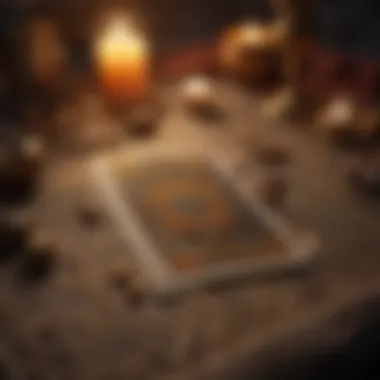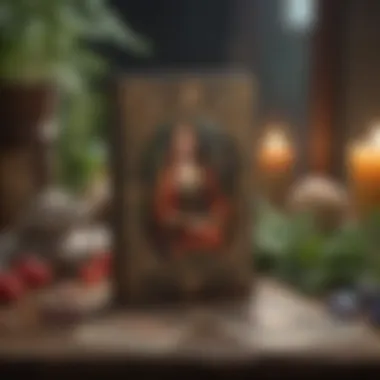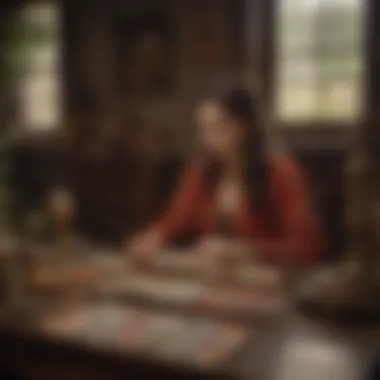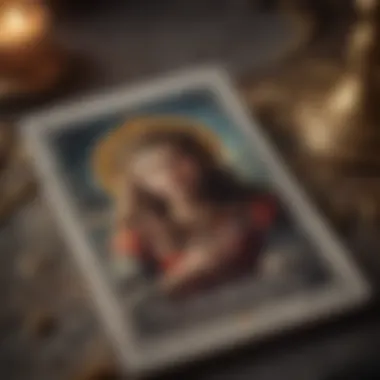Exploring General Tarot Reading: Insights and Resources


Intro
In the modern landscape of personal development, tarot reading emerges as a notable practice. It serves as a bridge between the known and the unknown, providing insights that many seek in times of uncertainty. Tarot, with its rich history and intricate symbolism, extends beyond mere fortune-telling. It fosters self-reflection and personal growth. For those new to tarot or even seasoned practitioners, understanding its foundations is paramount. This section will explore tarot's core principles and how free resources can enhance one’s reading experience.
Zodiac Sign Overview
General Traits
Each zodiac sign carries distinct characteristics shaped over millennia. These traits not only influence personality but also impact interpersonal relationships and everyday choices. Here are some common traits associated with each sign:
- Aries: Assertive, energetic, and pioneering.
- Taurus: Reliable, patient, and practical.
- Gemini: Adaptable, witty, and intellectual.
- Cancer: Compassionate, nurturing, and intuitive.
- Leo: Charismatic, confident, and creative.
- Virgo: Analytical, detail-oriented, and organized.
- Libra: Diplomatic, fair-minded, and sociable.
- Scorpio: Passionate, resourceful, and strategic.
- Sagittarius: Adventurous, optimistic, and philosophical.
- Capricorn: Disciplined, responsible, and ambitious.
- Aquarius: Innovative, unconventional, and humanitarian.
- Pisces: Empathetic, artistic, and dreamy.
Element and Modality
Astrology divides the zodiac signs into four elements: Fire, Earth, Air, and Water. Each element brings unique qualities:
- Fire signs (Aries, Leo, Sagittarius): Energetic and enthusiastic.
- Earth signs (Taurus, Virgo, Capricorn): Practical and grounded.
- Air signs (Gemini, Libra, Aquarius): Intellectually driven.
- Water signs (Cancer, Scorpio, Pisces): Emotionally profound.
Modality further categorizes signs into three groups: Cardinal, Fixed, and Mutable. This classification highlights the sign's approach to life.
Strengths and Weaknesses
Recognizing strengths and weaknesses helps individuals navigate their lives more effectively. Here is a brief outline:
- Aries: Strength - courage; Weakness - impulsiveness.
- Taurus: Strength - determination; Weakness - stubbornness.
- Gemini: Strength - versatility; Weakness - inconsistency.
- Cancer: Strength - empathy; Weakness - moodiness.
- Leo: Strength - leadership; Weakness - arrogance.
- Virgo: Strength - meticulousness; Weakness - overcritical.
- Libra: Strength - harmony; Weakness - indecisiveness.
- Scorpio: Strength - intensity; Weakness - jealousy.
- Sagittarius: Strength - open-mindedness; Weakness - tactlessness.
- Capricorn: Strength - practicality; Weakness - pessimism.
- Aquarius: Strength - originality; Weakness - aloofness.
- Pisces: Strength - creativity; Weakness - escapism.
Understanding these traits helps tarot practitioners interpret card meanings and navigate personal challenges effectively.
The amalgamation of zodiac characteristics along with tarot readings can provide fruitful insights into one’s life purpose and decisions. As we explore further, the connection between tarot and astrology will reveal deeper layers of understanding, guiding seekers through their journey of self-exploration.
Understanding Tarot Reading
The concept of Tarot reading serves as a bridge between the conscious and the subconscious. It offers individuals a unique means to explore their thoughts, feelings, and life situations through symbolic imagery. Understanding Tarot reading is essential as it provides not only insight into the mechanics behind it but also reveals its potential benefits for personal growth and self-reflection.
What is Tarot Reading?
Tarot reading is a practice that utilizes a deck of cards embedded with rich symbolism. Each card represents certain themes and meanings, which the reader interprets in context of the person's questions or circumstances. It is not merely a tool for predicting the future; rather, it serves as a revealing mirror into one’s psyche, offering clarity on various aspects of life.
The History of Tarot
The origins of Tarot can be traced back to the 15th century in Europe, where it began as a card game known as tarocchi. Over centuries, the cards evolved to take on mystic associations, becoming popular for divination and spiritual practices. Various cultures have influenced tarot, leading to different interpretations and decks that enhanced its depth and relevance in personal inquiry.
Components of a Tarot Deck
A standard Tarot deck consists of 78 cards, divided into two main sections: the Major Arcana and the Minor Arcana. Each section serves its own purpose and offers distinct insights into various life situations.
Major Arcana
The Major Arcana consists of 22 cards that represent significant life themes and archetypes. These cards often point to critical life lessons and personal transformations. A key characteristic of the Major Arcana is its ability to highlight crucial moments in one's life journey. For many readers, these cards provide profound insights and guidance, making them a central focus in tarot reading.
Minor Arcana


The Minor Arcana comprises 56 cards, which are further divided into four suits. These cards address the everyday aspects of life, capturing the nuances of daily experiences and challenges. The key aspect of the Minor Arcana is its detailed portrayal of life's intricacies. They help ground the reading and relate it to day-to-day realities, which can be beneficial for those seeking clarity on specific situations.
Suits Explained
The suits of the Minor Arcana offer a framework for understanding different areas of life. Each suit corresponds to an element: Wands for fire, Cups for water, Swords for air, and Pentacles for earth. This categorization aids in understanding personality traits, emotional currents, and practical aspects. The unique characteristic of the suits provides a foundational understanding of how different energies manifest in an individual's life.
Key Insight: Understanding the components of a Tarot deck enhances one's ability to interpret readings accurately, fostering deeper personal insights.
The Process of Tarot Reading
The process of tarot reading encompasses various steps that lay the foundation for a meaningful and accurate interpretation. Understanding how to approach a reading is crucial, as it can influence the insights gained from each session. This section explores essential components to enhance your tarot journey, focusing on preparation, different spreads, and interpreting the cards. Each element plays a integral role in ensuring that the reader connects with the cards effectively and draws insightful interpretations that resonate personally.
Preparation for a Reading
Before delving into a tarot reading, preparation sets the tone for the session. Creating a calm and focused environment is paramount. This can involve finding a quiet space, minimizing distractions, and gathering any tools that might enhance the experience, such as crystals, candles, or a journal for note-taking. It is also advisable to enter the reading with a specific question or intention, as this helps to channel energies towards a clear focus. Reflecting on one’s state of mind is equally vital—achieving emotional clarity contributes to more profound insights during the reading.
Types of Tarot Spreads
Tarot spreads serve as structured layouts to facilitate card interpretation. Depending on the intended outcome, different types of spreads can be employed. Here, three popular spreads will be discussed:
Three-Card Spread
The three-card spread is widely recognized for its simplicity and efficiency. It typically represents past, present, and future, making it an excellent choice for those seeking a quick overview of their situation. This spread’s key characteristic is its adaptability—it can be modified to explore various queries. Its unique feature is that it requires minimal cards, allowing for straightforward interpretations. However, its limitation lies in the potential for oversimplification; deeper issues may not be fully explored using only three cards.
Celtic Cross Spread
The Celtic Cross spread is perhaps one of the most intricate and comprehensive layouts available. It comprises ten cards and reveals multiple dimensions of a situation, including hopes, fears, and external influences. Its key characteristic is the depth of information it provides, offering a holistic view of the querent’s journey. This spread is a beneficial choice for individuals looking for thorough insights. The unique feature is the interplay between cards, which may lead to complex interpretations. However, its complexity can be a drawback for novices; it requires experience and confidence to decipher effectively.
Single-Card Reading
The single-card reading stands out for its focus and clarity. As the name suggests, this method involves drawing just one card, which provides an immediate insight into a question or situation. The key characteristic of the single-card reading is its immediacy, offering rapid insights without overwhelming the reader. This beneficial approach is especially helpful in daily guidance. The unique feature is its straightforwardness; it eliminates the complexities tied to multi-card spreads. Nonetheless, it may not provide comprehensive answers for more intricate queries.
Interpreting the Cards
Interpreting the cards is a crucial stage in the tarot reading process. Each card holds symbolic meanings and emotional connections tied to the querent's circumstances. The reader must rely on intuition and knowledge of the cards to provide insightful messages. Engaging with the cards can occur through journaling thoughts or meditating on the symbols present. This interaction brings forth a deeper understanding of both the cards and oneself, reinforcing the personal journey towards growth and enlightenment.
Benefits of General Tarot Reading
Exploring the benefits of general tarot reading reveals its multifaceted nature. Tarot serves not only as a divination tool but also as a means for introspection and personal growth. The art of tarot reading allows individuals to explore their inner selves, guiding them through complex emotions and situations. In this section, we discuss the significant advantages of engaging with tarot as a practice for self-reflection, decision-making, and intuitive connections.
Self-Reflection and Awareness
One primary benefit of tarot reading is its capacity for self-reflection and increasing awareness. When one engages with the cards, it fosters an environment conducive to introspection. This process encourages an individual to confront their thoughts and feelings without judgment.
Tarot cards present scenarios and questions that challenge existing perspectives. For instance, drawing The Hanged Man card may suggest a need to pause and reevaluate current circumstances. In this moment, a person might uncover deeper motivations behind their actions, allowing for more informed choices moving forward. Engaging with tarot helps to illuminate hidden aspects of a person's psyche, providing clarity in times of uncertainty.
Decision-Making Support
Tarot reading can also support decision-making processes. In situations where choices feel overwhelming, consulting tarot can provide a structured avenue to explore potential outcomes. By examining various aspects of a dilemma through tarot spreads, the reader gains insights into the consequences of each option.
For example, a three-card spread can help illustrate a past situation, present dilemma, and possible future. The insights gained through this reading may elucidate patterns or recurring themes in the decision process. Moreover, it offers a unique blend of analytical thought and intuitive guidance, often leading to more empowered choices.
Connecting with Intuition


Connecting with one’s intuition is another significant benefit of tarot reading. Intuition is a subtle yet powerful force that can guide decisions and enhance self-awareness. Through tarot, individuals can develop and strengthen their intuitive abilities.
The act of interpreting cards encourages readers to rely on their instincts. Each card carries meanings that resonate differently for each person. By taking time to meditate on both the imagery and symbolism of the cards, intuition can surface more readily. This connection allows individuals to trust themselves more fully, facilitating better outcomes in their personal and professional lives.
“Tarot is not just about forecasting; it is about understanding oneself and one’s paths.”
In sum, the benefits of general tarot reading encompass a wide range of personal and emotional growth opportunities. Engaging with tarot fosters self-awareness, supports informed decision-making, and strengthens intuition. By embracing these aspects, individuals can utilize tarot as a transformative tool in their everyday lives.
Accessing Free Tarot Reading Resources
Accessing free tarot reading resources is essential for anyone interested in gaining insight into tarot's principles without feeling financial pressure. These resources offer rich learning experiences, allowing users to uncover the depth of tarot's meanings and interpretations. Many people seek tarot for guidance, whether for personal growth or decision-making. Thus, having access to free resources democratizes this knowledge, making it available to a wider audience.
Online Tarot Readings
Online tarot readings have become increasingly popular due to their convenience and accessibility. Various websites offer free online tarot readings where users can select cards and receive interpretations without the need for a personal reader. This format allows users to explore and gain insight quickly. Also, many platforms regularly update their content, ensuring that users engage with current interpretations and trends in tarot.
The interactive nature of online tarot readings can also aid in self-reflection as users are prompted to consider their questions and feelings. Some reliable platforms for online tarot readings include:
- Tarot.com: Offers various free readings with detailed card explanations.
- Biddy Tarot: Known for its comprehensive resource library, including articles and interpretations that enhance understanding.
- AstroSeek: Provides free tarot readings and insights into astrology.
Mobile Apps for Tarot
In this digital age, mobile apps have simplified the accessibility of tarot readings. Numerous applications are available that offer free tarot readings at your convenience. These apps often come with additional features like daily draws, card meanings, and the ability to save past readings for reflection. The benefits of mobile apps include their ease of use and the ability to provide a personalized experience tailored to individual users. Some notable apps for tarot include:
- Labyrinthos: This app focuses on education and offers insightful features based on your choices.
- Golden Thread Tarot: Provides a comprehensive guide to card meanings and daily readings.
- Mystic Mondays: Known for its vibrant art and user-friendly interface that appeals to beginners.
Free Tarot Reading Websites
Free tarot reading websites serve as excellent sources for enthusiasts looking to learn more about tarot without spending money. Each website typically features unique spreads, card interpretations, and insightful educational content that enhances the reading experience. Some well-regarded sites include:
- Tarot Reading: This site offers a variety of free readings and interpretations for both novice and experienced users.
- Free Tarot: Focused solely on tarot readings, offering a large selection of spreads and cards.
- Labyrinthos Academy: This site not only features readings but also educational resources that are accessible for absolutely free.
Access to these resources enhances one's understanding of tarot while inviting personal insight and reflection.
By leveraging the available online readings, mobile apps, and websites, users can navigate their tarot journeys with ease. These resources empower individuals to engage in personal growth and self-awareness through informed practices.
Common Misconceptions about Tarot
Understanding common misconceptions about tarot is crucial for anyone interested in exploring its depth. Misunderstanding tarot can hinder potential benefits from this unique tool. Many presume it is solely about fortune telling, while others think the reader possesses mystical powers. Both views oversimplify a complex practice that fosters personalgrowth and insight. Clarifying these misconceptions can enhance one's ability to approach tarot with an open mind and gain valuable insights.
Tarot as Fortune Telling
The idea that tarot functions primarily as fortune telling is widespread but misleading. Tarot is not always about predicting future events. Instead, it serves as a reflective tool, providing insight into current situations and emotional states. The cards may reveal underlying influences affecting one’s choices and circumstances. Tarot helps individuals analyze their relationships, challenges, and aspirations. It can encourage self-awareness rather than just a prediction of what lies ahead.
Many readers and practitioners advocate viewing tarot as a guide for exploring personal situations. By asking focused questions and interpreting card meanings, users can engage in meaningful introspection. This approach emphasizes that tarot does not dictate fate but illuminates paths one might take based on current energies and choices.
"Tarot is more like a mirror reflecting the current state of one’s life than a crystal ball revealing the future."
The Role of the Reader
The role of the reader is often misunderstood. Many believe that the reader possesses an otherworldly ability to interpret the cards. However, a good tarot reader embodies more than just reading cards. They act as facilitators in the conversation between the cards and the querent. The reader's intuition and analytical skills enable them to interpret the cards based on context and personal experiences, rather than relying solely on predefined meanings.
Furthermore, the reader must create a space where the querent feels safe to express thoughts and emotions. The connection between the reader and querent plays a significant role in the reading's effectiveness. A skilled reader cultivates a rapport with the querent, ensuring that the session is collaborative and supportive, allowing deeper insights to surface. The reader reads the energies present and guides the querent towards self-discovery and empowerment.


Integrating Tarot into Personal Growth
Integrating Tarot into personal growth is a significant aspect of understanding its full potential. Tarot can serve as a profound tool for self-discovery, fostering a deeper connection to one’s inner self. When used thoughtfully, the cards can illuminate underlying patterns, facilitate awareness, and enable better decision-making in various life situations. This process underscores the practicality of Tarot, transforming it into not just a mystical practice, but a valuable resource for improving one’s life.
Creating a Tarot Ritual
Creating a Tarot ritual can enhance the effectiveness of readings and deepen their meaning. Rituals provide structure and intention, making the experience more sacred. It is not necessary to have complex ceremonies; simplicity often works best.
A starting point could be setting aside a specific time and place for readings. Having a clean, quiet space free from distractions allows for focused energy. Additionally, using objects like candles or crystals can help set the mood. Here are a few key elements to consider:
- Clear Your Mind: Take a few moments to breathe deeply and release distractions.
- Set Intentions: Decide what you wish to gain from the reading.
- Choose Your Cards Mindfully: Allow yourself to be drawn to cards that resonate with your inquiry.
Such rituals not only enhance your connection with the Tarot but can also lead to increased clarity and understanding of the messages within the cards.
Using Tarot for Daily Guidance
Using Tarot for daily guidance transforms it into a practical tool for everyday life. Rather than waiting for major events to seek direction, a daily draw can provide insights into routine challenges and opportunities. This consistent practice enables individuals to tune into their intuition more effectively.
Consider the following benefits of daily Tarot:
- Structured Reflection: A daily draw encourages regular self-reflection.
- Awareness of Patterns: Over time, recognizing recurring themes can guide personal growth.
- Decision-Making Aid: It can help clarify thoughts and feelings about choices each day.
These cards can act as conversation starters with yourself, opening avenues for introspection and planning.
Reflective Journaling with Tarot
Reflective journaling with Tarot allows for profound self-exploration. Writing about each tarot session can create a rich tapestry of insights over time. This practice merges the art of Tarot with the benefits of journaling.
When you keep a record of card pulls and interpretations, you enhance your understanding of the insights gained. Each entry can include:
- Card Drawn: Note which card or cards were drawn.
- Initial Thoughts: Write down your first impressions about the card.
- Questions for Reflection: Pose questions about how the card relates to your life.
- Personal Growth Noted: Reflect on any changes in thoughts or feelings over time.
Engaging in reflective journaling fosters an ongoing narrative of your journey, helping you document growth and transformation driven by Tarot insights.
"Tarot is not just about predicting the future; it is about understanding the present and integrating insights for growth."
By integrating these elements into your life, Tarot becomes more than a tool for divination; it evolves into a compass that guides your personal growth journey.
End and Future of Tarot Reading
The world of tarot reading is rich and multifaceted. As a practice that intertwines intuition, insight, and history, its future is bound to evolve in tandem with societal changes. This concluding section aims to encapsulate the significance of tarot and its place in a rapidly changing world, focusing on key elements such as adaptability, technology's influence, and the benefits of ongoing engagement with tarot resources.
Embracing the Evolving Nature of Tarot
Tarot is not a static practice; it is a fluid tool that reflects the changing human experience. Both seasoned readers and novices can benefit from this adaptability. Integrating modern perspectives into traditional readings can enrich interpretations. For instance, incorporating contemporary issues such as mental health and social justice can provide relevant context to the tarot spread. This broadening of scope allows tarot to stay pertinent in our lives, reinforcing its role as a means for exploration and understanding.
Furthermore, adapting tarot techniques or spreads based on personal experiences fosters a more individualized approach. Each reader may develop unique interpretations that resonate more deeply with their own circumstances. This personalized practice can lead to richer insights, enhancing the overall experience.
Sorcery of Modern Technology
Technology has transformed many aspects of our lives, including the practice of tarot reading. Digital platforms offer varied resources, enabling accessibility for eager learners and seasoned readers alike. Numerous apps are available, such as Golden Thread Tarot and Tarot Card Reader, which facilitate guided readings right from a user's smartphone. This convenience can encourage exploration into tarot for those who might initially resist or feel intimidated.
Besides applications, websites like Keen and Biddy Tarot also provide in-depth information, communities, and interactive resources. These platforms make tarot learning more engaging and offer a supportive environment for discussion and inquiry.
Many tarot enthusiasts take advantage of social media, sharing tips, personal readings, and new interpretations. Facebook groups and Reddit communities allow for diverse discussions and support, fostering connections between people passionate about tarot.
While embracing technology, it is important to maintain the essence of tarot. The intuitive aspect remains crucial in every reading, whether conducted in-person or digitally. Balancing traditional knowledge with modern advancements can shape a future for tarot that is inclusive and engaging.
By recognizing the evolving nature of tarot and harnessing the power of technology, we open ourselves to a wealth of insights and experiences that can guide personal growth and self-exploration.







